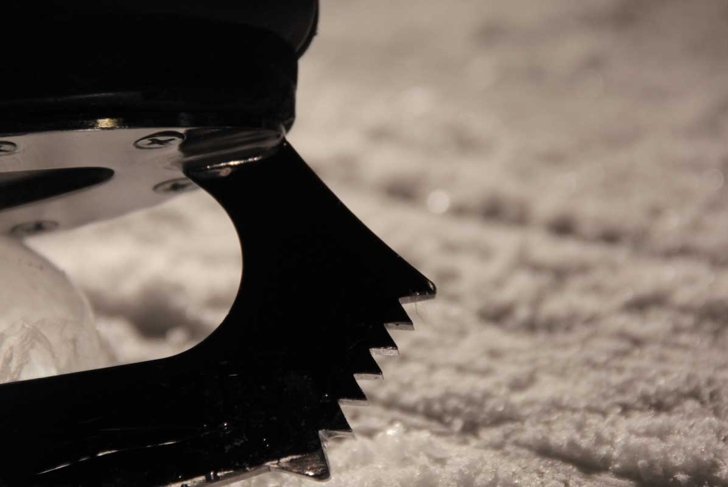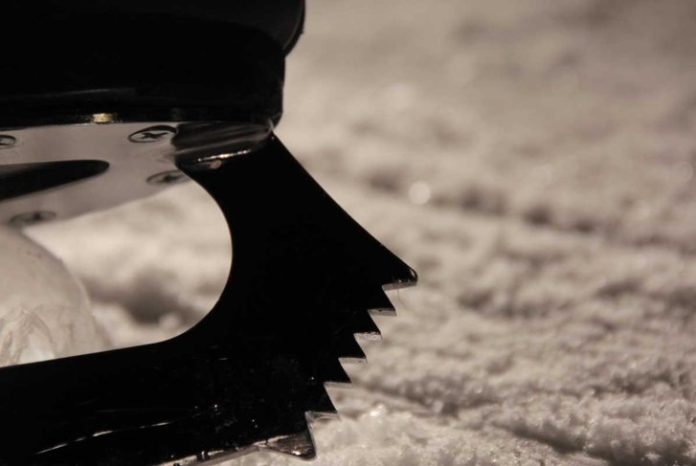
“Dem bones, dem bones, dem dry bones …”—20th-century spiritual song
I was gliding backward. I closed my eyes for a brief moment, praying as much for bravery as for success. Then I committed, stepping forward and launching myself into the air. After completing one-and-a-half rotations, I landed cleanly—thud. My Axel had been mastered.
Then I landed it again.
And again.
And again.
Thud. Thud. Thud.
For months I had been having more success with increasingly complicated jumps. Singles became doubles, and I was gaining more height and more speed. I was finally becoming the athlete I had envisioned when I began figure skating at the age of seven (after watching my older cousin perform in an end-of-year show to Kermit the Frog’s “Rainbow Connection”—I have always been sentimental).
Now, if only that knee pain would subside
Swelling had appeared on both my knees just below the patella. Ice packs helped for a while. Eventually, I would swallow a couple of anti-inflammatories with my post-practice blueberry slushie. Then two became four, which became eight.
My pediatrician sent me for X-rays; I was diagnosed with Osgood-Schlatter disease. The tops of my tibias had been shattered as a result of the repeated pounding they sustained while cushioning my jumps. My orthopaedic landing gear was failing. My career path to triple Axels was over.
What now? I had to not only heal but also find another way to stay active doing something I loved.
A natural part of aging
I was experiencing at an early age what we all eventually will be subjected to: joint and muscle pain. While mine was triggered prematurely due to excessive wear and tear, all of us will suffer degradation and loss of our cartilage, bone density, and muscle strength. It is a natural part of the aging process.
Dr. Pascal-André Vendittoli, a professor at the University of Montreal, is an orthopaedic surgeon with a sub-specialty in hip and knee replacement. He says that past the age of 40, we lose about 1 percent of our bone density annually. (Rue the day we live to be 140 years old: our hearts will be beating, but we’ll be boneless piles of goo waiting for a very able-bodied Uber driver.) He adds that for many people, the degradation can be more severe.
“We know that in the general population there are about 15 percent of people who will really suffer from wear and tear on their knees and hips throughout their life. They will need to receive treatments to try to improve their condition. This can be a medical treatment, or a surgical treatment to replace the joint with a prosthetic,” says Vendittoli.
Vendittoli emphasizes that surgery is a last resort, to be considered only once the chronic discomfort and lack of function interferes with daily tasks such as walking, standing, or being able to perform your job.
Managing joint pain and bone and muscle loss
So, what can be done throughout those intervening years? How can one manage joint pain and bone and muscle loss before they become unbearable?
Manage stress
Amanda Capasso is a naturopathic doctor at The Root Natural Health Clinic in Mississauga and Connected Health and Skin in Toronto. She says that one of the most important steps in managing bone loss is managing stress. This will reduce your body’s natural hormonal reaction to anxiety and worry, which can be damaging.
“Having long, chronic elevated cortisol is not great for bone health. It creates a lot of inflammation, and it just changes … your bones, how much calcium they release back into your bloodstream, and how much they take out.”
Capasso says that stress reduction can be as simple as reorganizing your priorities and giving yourself a little bit more time for a walk, or yoga, or meditating.
She says that your stress reduction should <not> be an additional burden to your already busy life. “Some people are going to hate meditating, and some people are going to hate yoga … So it’s just individualizing care and finding what works for them. For a lot of people … it’s just taking a bath or going to get your nails done.”
Consider your diet
Diet also plays a big role in bone and muscle health. Capasso has seen a lot of success with patients who have switched to the Mediterranean diet—reducing red meat and adding more vegetables, oils, and fish. Even that, she says, should be as simple a process as possible to avoid discouragement.
“Buy some broccoli. And if people are like, ‘Really, I can’t do this,’ buy some frozen broccoli,” she says. “[It] really easy to throw in the oven.
“In the morning, add a handful of spinach to your smoothie just to get some greens in. Make a homemade salad dressing with a cup of [extra-virgin] oil in it that will last you for the week. There, you’re getting a ton of olive oil.”
If you do find yourself on the floor of the produce aisle strangling your arch nemesis, the broccoli floret (I once lost a battle with a particularly spiky artichoke), supplements can also promote healthy joints.
Vitamin D is vital for bone health—especially during Canada’s dark winters; nearly one-third of Canadians are vitamin-D deficient.
Turmeric is an excellent anti-inflammatory.
However, Capasso explains, both turmeric and vitamin D should be emulsified in fat to reap their full benefits. Most liquid forms of vitamin D fall into that category. As for turmeric, Indian recipes often include ghee—a type of clarified butter—because it helps the body absorb the spice properly. (Hello, butter chicken!)
Natural treatments for joint and muscle pain
Capasso also suggests alternative forms of treatments for joint and muscle pain.
Acupuncture
“Acupuncture can be really beneficial, to get the needles right in there and do electro stimulation,” says Capasso. “And there’s castor oil—used topically, not internally.”
Exercise
Both professionals agree that there is no substitute for regular exercise. Vendittoli says, “When it comes to hips and knees, you cannot stop moving. Quite the opposite … It could become a vicious circle. When you have pain from wear and tear in your joints and you stop moving, it becomes worse and worse.”
If you are experiencing joint or muscle pain, Vendittoli suggests switching to a less impactful activity such as walking instead of running, or swimming instead of tennis.
Following the diagnosis that put my dreams of a triple Axel on ice, I, too, modified my workouts. I became a competitive ice dancer (no jumping allowed). The highlight of my second career was representing my home province of Quebec in a competition held at the Olympic arena in Lake Placid, NY.
My partner and I performed on the same surface where, only a decade earlier, the American men’s ice hockey team defeated the Soviet Union to claim the gold medal. Their story was enshrined in the movie Miracle on Ice.
I realize now—as I use yoga and jogging to manage my own arthritis and degenerated discs gifted to me by 17 years of figure skating—that that ice arena and I have something in common: we both have a lot of history in our bones, but we’re still standing.
Cherries can help
Tart cherry juice may be especially beneficial against joint pain caused by gout or osteoarthritis. If guzzling a glass full of tart juice furrows your face, eating about 20 tart cherries will do the job of battling inflammation.
The cannabis connection
More and more seniors are asking their doctors about cannabis as a non-medical treatment for persistent joint discomfort. The effectiveness of medical cannabis against chronic pain in adults has the support of the National Academy of Sciences.
Hip bone to the knee bone—how to build a lifelong connection
Yoga shouldn’t hurt
Daily gentle stretching maintains flexibility and prevents injury.
Walk it off
Going for a daily 30-minute walk can have life-saving benefits. And, according to experts, the faster, farther, and more often you walk, the greater the benefits.
Bear the burden
Weight-bearing exercise, even using weights of as little as 2 or 3 lbs (1 or 1.5 kg), can slow bone loss.
Don’t worry, be happy
Spend time with friends and family and do something you love. Mental health is as important as physical fitness.



